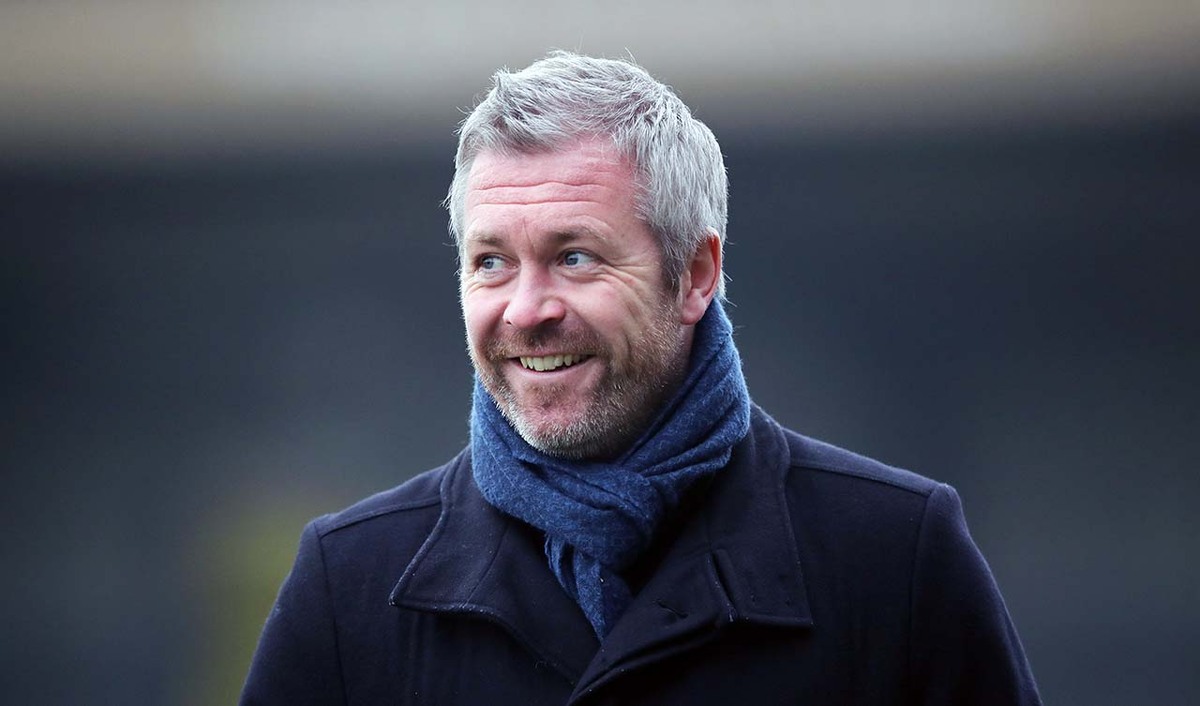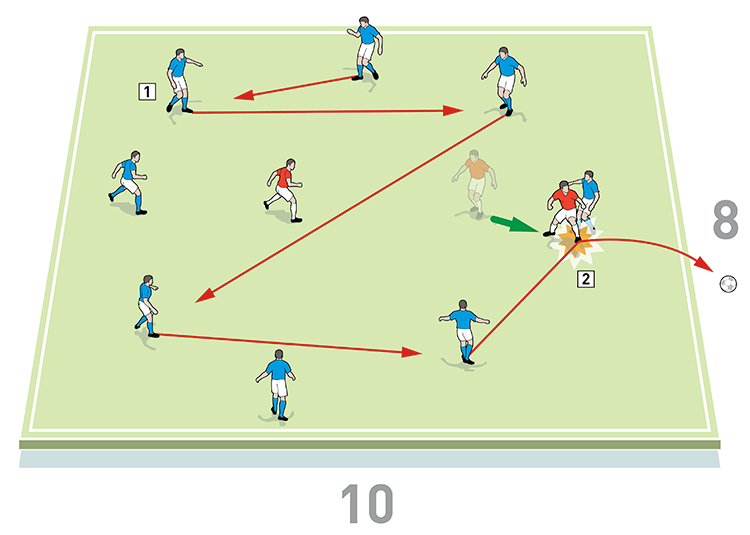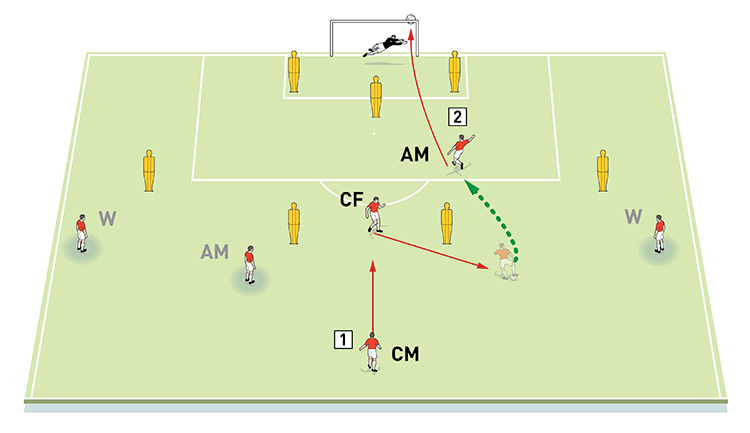Match day preparation
This session is designed to be run as match preparation on Match Day -1 and it is our last training session before a game. By the end of the session we have to ensure that all the final details are covered in order to be satisfied that we have prepared the players properly for the up and coming match.

| Area | Up to full pitch |
| Equipment | Balls, bibs, cones, mannequins, 2 goals |
| No. of Players | Up to 20 players + 2 goalkeepers |
| Session Time |
Warm-up rondo: 7mins, 11v11 game: 20mins, Unit work: 15mins, Small-sided game: 8mins |
This session is designed to be run as match preparation on Match Day -1 and it is our last training session before a game. By the end of the session we have to ensure that all the final details are covered in order to be satisfied that we have prepared the players properly for the up and coming match.
In a lot of ways, it is our most important session of the week. Final details about set-pieces are given to the players and the session basically summarises everything that we have worked on earlier in the week. We use this session to reiterate the most important parts of our game plan and we deliver our final messages to the team.
What do I get the players to do?
Warm-up rondo
After the players carry out the prehab work in the gym, they run through a number of movement and activation exercises [not shown] with the physical performance coach to prepare themselves for the session. This usually lasts 10 to 15 minutes.
Next we set up two 10x8 yard rondo boxes (we’re showing just one here, but we use two to include the full squad). We’re using 10 players in each rondo box, playing 8v2. The eight blue players pass the ball to keep possession under pressure from the two red defenders, who try to win the ball and clear it out of the area, as shown [1]. The player who lost possession switches roles with the defender who cleared it out of the area and play continues. We play four minutes at two-touch and three minutes at one-touch. With the touch restrictions, the passing players should always be thinking about their options when they receive the ball.
1

2. The two red defenders try to clear the ball out of the area. The defender who clears it switches roles with the player who lost possession and play continues
If the possession team manages to string 15 passes together, the two defenders stay in for another round.
We want the players to take this seriously but we always try to ensure that there is an element of fun to the session, so nutmegs and passes that split the defenders count as three passes.
What do I get the players to do next?
11v11 game
Next we set up on a full pitch for an 11v11 game [not shown]. The starting 11 will have been named in the team meeting prior to training. We will play 11v11 for approximately 20 minutes, stopping and starting play frequently to recap the tactical work that has been covered during the week. We will also ensure the players are comfortable with the plan for our ‘build’ from the goalkeeper, our ‘press’ from the front, and we run through our set-pieces as they happen during normal play. We will manufacture any set-pieces that don’t happen naturally and ensure that the opposition re-enact what we expect from the next day’s opponents.
What do I get the players to do next?
We split the group so defenders and attackers go into their own separate practices to train as units.
Unit work: attacking
The forward players will work on their crossing and finishing and will try some combinations that we have identified will work in the forthcoming match.
We set up for the attacking practice in the final third of the pitch, with a goal and a goalkeeper in their normal positions. Mannequins are set up to represent defenders. We’re using six outfield players: two wingers, two attacking midfielders, a centre midfielder and a centre forward.
Here we are running two attacks. In the first attack, as shown [2a], we work on attacking movement and finishing. The centre midfielder starts play by passing into the centre forward, who lays the ball off to the attacking midfielder on the right for a touch and a shot.
2a

2. The centre forward lays the ball off to the attacking midfielder, who drives forward and shoots
Immediately after the first attack is dead, the second attack begins, working on scoring from cutbacks. The centre midfielder starts play again by passing into the centre forward, who lays the ball off to the attacking midfielder on the left, as shown [2b]. The attacking midfielder passes to the left winger, who receives on the run and takes the ball to the by-line before cutting back. After making his pass, the centre forward has made a run into the box, creating space for the attacking midfielder to meet the cut back and shoot first time. The right winger has also made a back post run into the box to support the attack.
2b

2. The centre forward lays the ball off to the attacking midfielder and then makes a run into the penalty area
3. The attacking midfielder passes to the left winger and makes a forward run
4. The left winger receives on the move and takes the ball to the by-line before cutting back to the midfielder, who shoots first time
5. The right winger makes a supporting back post run
Unit work: defending
The defensive players will normally work on defending crosses into their penalty area and work as a unit to defend the space in behind. We will also try to include some transitional work too. Here we show the players working on defending crosses and second balls.
We set up in the final third of the pitch, with a goal and a goalkeeper in their normal positions. We’re using eight players, split into a defending unit of five and three attackers. The defenders line up with a back four and a defensive midfielder, while the attackers have two wide players and a centre forward. The centre forward starts play by combining with the wingers to set one of them up to cross into the penalty area and the back four have to defend with the help of a defensive midfielder, as shown [3].
3

2. The back four have to work as a unit to defend against the cross. Here they drop together and when one clears the ball, they all push up as a unit
3. The defenders link with the defensive midfielder to clear the ball to safety, so the team can launch a counter-attack
How would you put this into a game situation?
Small-sided game
We set up an area of 24x36 yards with a goal and a goalkeeper at each end. We’re using 20 outfield players split into four teams of five. Two teams play a 5v5 game for 60 seconds, while the other two teams wait off the pitch for their turn to play each other. Each new game starts with a direct shot at goal from one of the new teams coming onto the pitch, as shown [4].
4

2. Two more teams wait off the pitch for their turn to play each other
3. Each new game starts with a direct shot from one of the new teams coming onto the pitch. Teams take turns to take the starting shot in each game
4. If a team scores, they restart play from their own goalkeeper
If a team scores, they restart play from their own goalkeeper.
We play eight 60-second games, with the teams taking turns to start play – each team takes the starting shot every other game.
What are the key things to look for?
We need to ensure that the starting 11 are very clear on their roles and responsibilities during the session, both in and out of possession and regarding set-pieces. If there are any doubts or questions, we need to nail them before the players leave the training ground that day.
This means that if something isn’t working, as coaches we need to be comfortable making changes.
What are the typical mistakes players might make and how do I avoid them?
At times the players can overthink certain things and they might want a black and white answer but occasionally the answer is grey, so we need to ensure that the players are empowered to make good decisions during the match the following day.
How do I progress the session?
The session changes slightly every week in terms of the detail within it because we are always making our game plan specific to the identified strengths and weaknesses of our next opponents. However, it will be very much kept within our own playing principles.
Sometimes we will make changes to the rondos, amending the area size or the conditions. We may also leave out unit work some weeks.
Editor's Picks
Attacking transitions
Deep runs in the final third
Using the goalkeeper in build-up play
Intensive boxes drill with goals
Penetrating the final third
Creating and finishing
My philosophy
Pressing initiation
Compact team movement
Coaches' Testimonials

Alan Pardew

Arsène Wenger

Brendan Rodgers

Carlos Carvalhal

José Mourinho

Jürgen Klopp

Pep Guardiola

Roy Hodgson

Sir Alex Ferguson

Steven Gerrard
Coaches' Testimonials

Gerald Kearney, Downtown Las Vegas Soccer Club

Paul Butler, Florida, USA

Rick Shields, Springboro, USA

Tony Green, Pierrefonds Titans, Quebec, Canada
Join the world's leading coaches and managers and discover for yourself one of the best kept secrets in coaching. No other training tool on the planet is written or read by the calibre of names you’ll find in Elite Soccer.
In a recent survey 92% of subscribers said Elite Soccer makes them more confident, 89% said it makes them a more effective coach and 91% said it makes them more inspired.
Get Monthly Inspiration
All the latest techniques and approaches
Since 2010 Elite Soccer has given subscribers exclusive insight into the training ground practices of the world’s best coaches. Published in partnership with the League Managers Association we have unparalleled access to the leading lights in the English leagues, as well as a host of international managers.
Elite Soccer exclusively features sessions written by the coaches themselves. There are no observed sessions and no sessions “in the style of”, just first-hand advice delivered direct to you from the coach.









